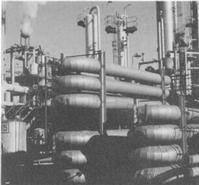


Chapter 9
I Introduction
II The Australian Chemical Industry
III Pharmaceuticals
IV Chemists In Other Industries
V The Dawn Of Modern Chemical Industry - High Pressure Synthesis
VI The Growth Of Synthetic Chemicals - Concentration, Rationalisation And International Links
VII Australian Industrial Chemical Research Laboratories
VIII The Plastics Industry
i Plastics processing
ii Phenol - basis of the first plastic
iii Plastics - the first generation
iv Plastics - the second generation - from petrochemicals
v Styrene monomer - the West Footscray petrochemical complex
vi The Botany petrochemical complex
vii The petrochemical complex at Altona
viii CSR - from sugar alcohol to petrochemical OXO alcohol
IX The Paint Industry
X Acknowledgements
References
Index
Search
Help
Contact us

The process itself, however, was only half the issue. To create adequate markets a major effort of process and end-use development for the derivatives was needed: Polyethylene glycol (polyol) plants, new surface active agents and a multiplicity of new uses for their variants in many industries.[122] The polyols were one of the two principal constituents of polyurethane plastics.
Another example of polyol development was brake fluids. Ethylene oxide derivatives had long been used as brake fluids because of a number of advantages; thus for example they do not attack rubber or plastic tubing, but, cars were changing, becoming faster and automatic. Disc brakes appeared, and these changes led to increases in the heat generated in braking systems under normal conditions; under severe conditions these led to vapour lock and brake failure. So new, higher boiling point brake fluids were needed. A second problem with brake fluids was their tendency to absorb water from the atmosphere. On heating this water evaporated and again could cause vapour lock. Researchers overcame the problem by an ingenious, simple device: they designed a brake fluid molecule, which reacted with water, thereby removing it and which in the process was converted into a secondary brake fluid. As a result this formulation retained its boiling point over longer periods, and provided added safety.
The process of market penetration had begun before the plant was built and continued for some years. Finally, ICI Australia's chemists had the satisfaction that not only did their UK colleagues follow them in process selection -the Scientific Design process -but they even purchased know-how on ethylene oxide derivatives and plants from the subsidiary. By 1963 the ethylene oxide plant was completed, on line and performing well. The third step to the Botany ethylene cracker was in place (Fig. 31).

It was a new phase for Australia's chemical technology; the entry into fully integrated petrochemical, plastics and plastics processing industry some key elements of which rested on competitive advantages derived from Australian industrial research.
The Botany plant was systematically expanded by plant research extending yields and productivity ('debottlenecking') and by a series of incremental expansions until the limit of ethylene capacity was reached. In 1977 a polypropylene plant was added; in 1981/83 a major $400 million plant expansion including a new 250 000 tonnes ethylene cracker and extensions of the polythene and ethylene oxide plants were undertaken.
Events in due course showed that some problems remained -one visible and one hidden. Chemical engineers were aware that the race for scale benefits was one of converging curves with an ever-eluding point of intersection. While the Australian cracker was being designed, almost up to world scale, that scale virtually doubled. The other was dependence on imported naphtha. Within ten years, as the result of the so-called oil crisis, the price of naphtha increased tenfold, while competitive plants overseas enjoyed access to cheaper local natural or by-product hydrocarbons.
Organisations in Australian Science at Work - Botany Petrochemical Complex
 |
Australian Academy of Technological Sciences and Engineering |  |
© 1988 Print Edition pages 707 - 708, Online Edition 2000
Published by Australian Science and Technology Heritage Centre, using the Web Academic Resource Publisher
http://www.austehc.unimelb.edu.au/tia/673.html